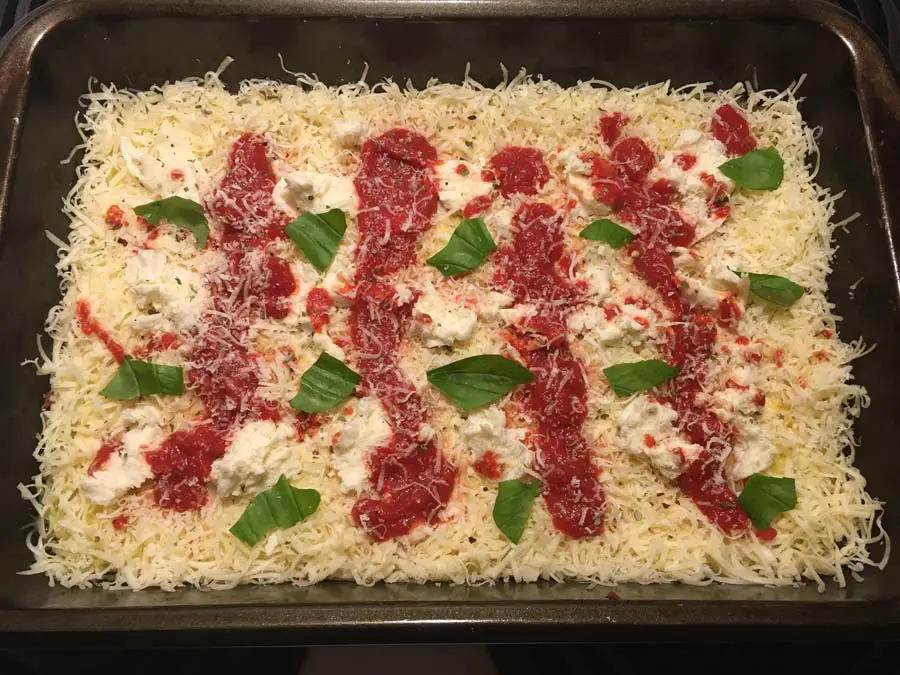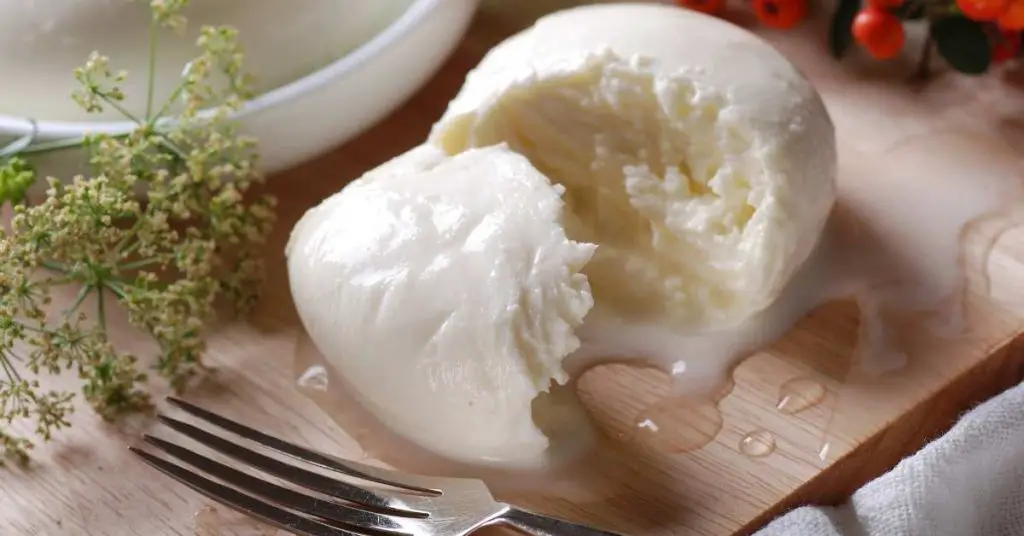Which Mozzarella Cheese Is Best For Pizza? Low-Moisture Mozzarella Vs Fresh
Pizza comes in many different sizes, shapes and flavors. But one of the most consistent characteristics of pizza is cheese. Mozzarella cheese is by far the most popular topping on pizza anywhere, but in a world full of different types of mozzarella cheese, which one is best?
The best mozzarella cheese for homemade pizza is a blend of fresh and low-moisture mozzarella. This blend of cheese will give your pizza the creaminess of fresh cheese but without the excess water that normally comes with it. This cheese blend works especially great on American style pizza.
But that doesn’t mean this is always the best choice. The best mozzarella cheese for your pizza really depends on what kind of pizza you’re aiming for, and often which side of the Atlantic you’re coming from.

What’s The Difference Between Fresh and Low-Moisture Mozzarella Cheese?
When I was a kid growing up in NYC, mozzarella cheese was mozzarella cheese. I knew there were different brands but didn’t pay too much attention to the different types. In fact, I didn’t even know there were different types of mozzarella to know about.
But the truth is there are some key differences between fresh and low-moisture mozzarella cheese that can really affect the finished product of your pizza.
Fresh mozzarella is made from whole-milk, enzymes and salt. Low-moisture mozzarella, on the other hand, is an American mozzarella variant made the same way but processed further. The fresh mozzarella is “soured” then dried out with extra salt added to increase the shelf life. Fresh mozzarella is typically much softer and wetter than low-moisture mozzarella.
Generally speaking, fresh mozzarella is better for eating raw. I know I could eat a whole batch of fresh mozzarella all by itself – the fresh creamy taste is almost unbeatable in the world of cheese.
Fresh mozzarella is so simple and fresh that it can actually be made at home quite easily with just a bit of whole-milk and the correct enzymes.
Low-moisture mozzarella can be eaten raw but it isn’t nearly as common, and is virtually unheard of outside of America. I know some people like eating “string-cheese” but personally I find it a bit gross. Low-moisture mozzarella is much better suited to being melted and combined with other ingredients before eating.
That’s the basic difference between fresh and low-moisture mozzarella in terms of how they’re made and used, but let’s get into which types are better on different kinds of pizza.

Fresh Mozzarella Cheese Is Best For Neapolitan Style Pizza
It’s no secret that Italians are extremely particular about the ingredients they put on their food. On the other hand, Italian-Americans (like myself) tend to be a lot more flexible and have incorporated many American ingredients in their recipes over the generations.
But Neapolitan pizza is not one of these instances where it’s OK to stray too far from the original recipe. Especially not when it comes to cheese.
The best cheese for Neapolitan style pizza is fresh mozzarella. Fresh mozzarella has the perfect creamy flavor and fresh notes that pair perfectly with a fresh tomato sauce and fresh basil that Neapolitan pizza is known around the world for.

Neapolitan pizza is sparsely topped compared to American styles of pizza, and this includes the cheese.
Tip: Don’t use too much fresh mozzarella on a single pizza or the excess liquid won’t have a chance to evaporate. This can make the crust soggy, so keep it to 80-100g per pizza.
For this style of pizza the cheese is often cut into small cubes or batons and placed sparingly on top of the sauce, usually in quantities of around 80 grams per pizza. The cheese is then melted just until it starts to bubble but not to the point where it forms into the brown crusty bubbles that are so common on American pizza styles.
Fresh mozzarella cheese usually comes packed in small tubs of its own whey to help keep it soft and wet. This means the cheese, when melted, will have a lot more excess liquids coming from it than low-moisture mozzarella. But because Neapolitan pizza uses far less cheese than American styles, those extra liquids are evaporated fairly quickly.
Fior Di Latte Vs Mozzarella Di Bufala
All fresh mozzarella shares certain similarities, when compared to low-moisture, but it isn’t all made the same way.
The two main varieties of fresh mozzarella is fior di latte and mozzarella di bufala.
Fior di latte is made from cow’s milk, just like low-moisture mozzarella, and is the most common type of fresh mozzarella served on pizza in Italy. This cheese has a super creamy taste and almost melts in your mouth.
Mozzarella di bufala is made the very same way as fior di latte except it uses the milk of water buffalos. This cheese tastes very similar to its cow’s milk counterpart but with a slightly more sweet and tangy flavor.
Either one of these fresh cheeses will work great on a Neapolitan style pizza, but mozzarella di bufala is often placed raw on an already baked crust. This helps to preserve the amazing texture and sweetness it’s known for.
There are other types of fresh mozzarella as well, like bocconcini and burrata, but these aren’t typically served on pizza. But if you’re looking for a treat, give burrata a try – it’s basically fresh fior di latte with a soft and cream-filled middle. Burrata is amazing all by itself or with a bit of salt and olive oil drizzled on top.
Low-Moisture Mozzarella Is Better Suited To American Pizza Styles
There are lot’s of different styles to American pizza but let’s stick with the classic NYC pie since it’s a frame of reference most people are familiar with.
Low-moisture mozzarella cheese is the best kind of cheese to use on a New York City style pizza. This is because the cheese is drier and browns better to suit most Americans’ pizza preferences.

Anyone who’s had a NYC slice of pizza knows that characteristic dark orange tinge to the cheese. This happens because American pizza is usually baked for quite a bit longer than Neapolitan styles which are done in under 90 seconds.
Another effect of baking the pizza for a longer period of time is that the fat begins to separate from the rest of the cheese, giving that classic oily drip so common in NYC, especially in cheaper pizzerias.
Quantity plays a big role in which type of mozzarella is best for a pizza as well. American style pizza, as in NYC, typically has much more cheese than a Neapolitan style.
Tip: Stick to whole-milk, low-moisture mozzarella if it’s available to you. The extra fat will melt better and won’t burn as quickly in the oven compared to skim.
The comparison is somewhat difficult to make in terms of net weight of the cheese because NYC pizza is much bigger than Neapolitan, but consider that a 14″ NYC pizza (on the small side) has about 200 grams of low-moisture mozzarella.
Compare this with a Neapolitan pizza which is usually between 11-12 inches and has only 80-100 grams of fresh mozzarella on average.
This is a massive discrepancy in cheese and is part of the reason why low-moisture is preferred over fresh for NYC pizza, and the reason has mostly to do with moisture.
Low-moisture mozzarella, as you can probably guess by the name, has less moisture than fresh mozzarella. In a super-hot Neapolitan pizza oven, the excess moisture in only 100g of fresh mozzarella cheese will evaporate very quickly.
On the flip side, 200 or more grams of fresh mozzarella on a NYC pizza will usually end up in puddles of water on top of the crust. This will make the pizza soggy and difficult to eat, especially while on the go as New Yorkers love to do.
So if you’re going for a slightly oilier pizza with lot’s of cheese and a bit of browning, low-moisture mozzarella is probably your best bet. This applies to almost all American styles of pizza as well, even ones that don’t use mozzarella at all.

The Best Brand Mozzarella Cheese For Pizza
Since I published this article earlier this year, several people have asked me for whole-milk low-moisture mozzarella brand recommendations. This is a great question and something I had overlooked when originally writing this.
The best brand mozzarella cheese for pizza is whatever kind of whole-milk mozzarella is available at you’re local market. Whole-milk, low-moisture mozzarella cheese always melts well and tastes great on American style pizza due to its extra high fat content and rich flavor. Some common brands that I like include Polly-O, Galbini and Saputo.
But almost any brand of whole-milk low-moisture mozzarella will get the job done just fine, so to be honest I don’t really pay too much attention to the brand I’m buying – as long as it’s a reputable one. And of course double-check that the cheese you’re buying isn’t labeled as “part-skim”.
But if you live in a part of the world where whole-milk mozzarella isn’t available, thankfully Amazon has some good offerings as well. Here are a few quality cheeses to choose from:
Do you have a favorite brand whole-milk mozzarella cheese to recommend in your area? Let us know in the comment section below.
How To Avoid Watery Fresh Mozzarella Cheese On Pizza
Fresh mozzarella cheese has a reputation for being watery, and with good reason. It has way more moisture than its low-moisture American counterpart.
Many professional pizza makers, at least the American ones, have sworn off fresh mozzarella completely because they don’t want puddles of water on their crust.
Tip: Avoid tearing fresh mozzarella off in large chunks like some recipes tell you. These chunks won’t melt well and the edges might burn.
I can understand this – no one wants puddles of water on dripping from their slice of pizza. But it doesn’t have the be this way, even in a lower temperature home oven that can’t zap away the moisture in under 90 seconds.
I actually prefer to use only fresh mozzarella on my pizzas because most of the time I’m looking to keep things light and fresh.
The key to preventing watery pizza when using fresh mozzarella is to cut the cheese into small pieces beforehand. I usually cut my cheese into small baton or julienne shapes and then let it sit at room temperature while I prepare the rest of the ingredients. This gives the cheese time to dry slightly and for any excess moisture to drain away before baking.
If you’re dealing with a particularly moist cheese, you can cut it up the night before and leave it in a closed container in the fridge. Your fresh mozzarella will still be soft and moist but without the excess liquid that will cause puddles on your pizza.
But with all that being, don’t be afraid of a little extra moisture. I sometimes like when a bit of the liquids from the cheese mixes in with the sauce and creates a pinkish, creamy umami concoction. It tastes delicious as long as there isn’t so much liquid that it makes the crust soggy.

How To Get The Best Of Both Worlds
Fresh and low-moisture mozzarella each have a place in their respective pizza worlds, but what if you want the best of both worlds?
I alluded to this in the opening section and I think it’s a great way to end a post discussing the pros and cons of each type of cheese.
Fresh mozzarella is creamy and soft but if you add too much of it you’ll wind up with a watery mess. Low-moisture mozzarella can be tasty but too much of it will leave you bloated and sick.
This is why I think a mix of fresh and low-moisture mozzarella is best for most home pizza makers. Mixing the two gives you the creaminess of fresh cheese and the extra cheesiness of low-moisture cheese, all without puddles of water or a sick stomach afterwards.
Just remember to keep a close eye on the fresh cheese as it bakes to prevent burning. Fresh mozzarella is a bit more delicate and can burn easily under direct heat for too long. You want to remove it from the oven when it’s gently bubbling and not at the point when it’s crusted over.

Final Thoughts
For the most part, fresh mozzarella vs low-moisture mozzarella is a matter of personal preference and what style of pizza you’re aiming for.
American style pizzas can do well with either pure low-moisture mozzarella or a combination low-moisture and fresh. On the other hand, no self-respecting Italian pizza maker will use American style low-moisture mozzarella cheese, especially not if they’re from Naples. In Italy, fresh mozzarella is king.
American pizza bakes longer at a lower temperature and so fairs better with a lower moisture cheese to avoid sogginess, especially in large quantities. Neapolitan pizza bakes very quickly at a high temperature and with less cheese, so fresh mozzarella is best.
Home-based pizza makers will probably do best with a combination of fresh and low-moisture mozzarella due to the lower temperatures of home ovens. This will give you the creamy taste of fresh cheese along with an extra-cheesy like quality of low-moisture mozzarella. No puddles of water and no feeling sick afterwards.
Of course, this is a simplification to help get you started. There is a whole world of cheese out there and so many different ways to use them on pizza. So whatever cheese you choose, good luck!







Hi Domenic
What brand of whole milk-low moisture and fresh mozzarella cheese do you recommend?
I like the american style pizza with lots of chewy melted cheese.
Hi Ken! Thanks for the question. Honestly, any brand of mozzarella that’s made from whole-milk will do just fine on any pizza. But I like the Polly-O brand which is pretty popular and is available in lots of supermarkets. I also like the Galbani brand which you can find on Amazon.
But like I said, whole-milk is the key. As long as it’s whole-milk, and not part-skim, it should melt and taste great. Hope that helps!